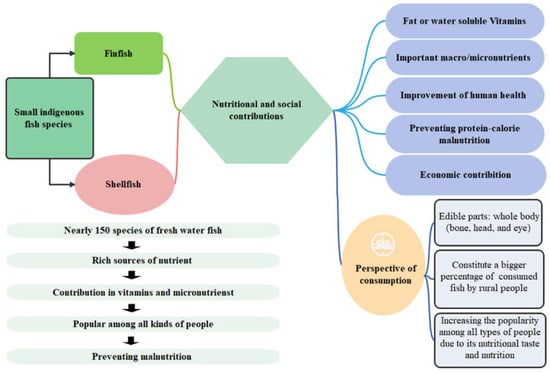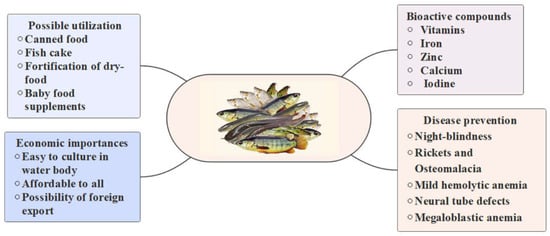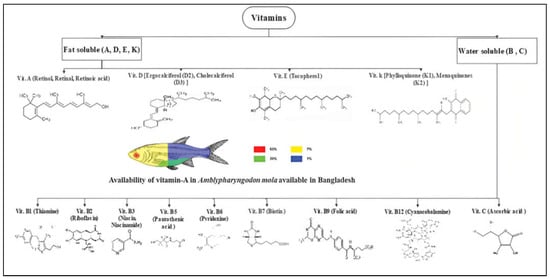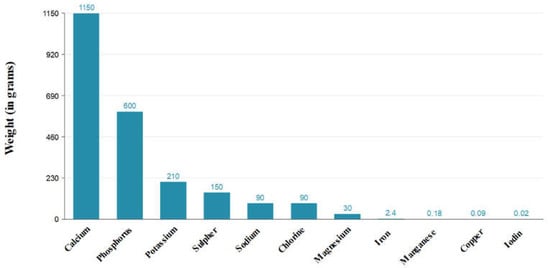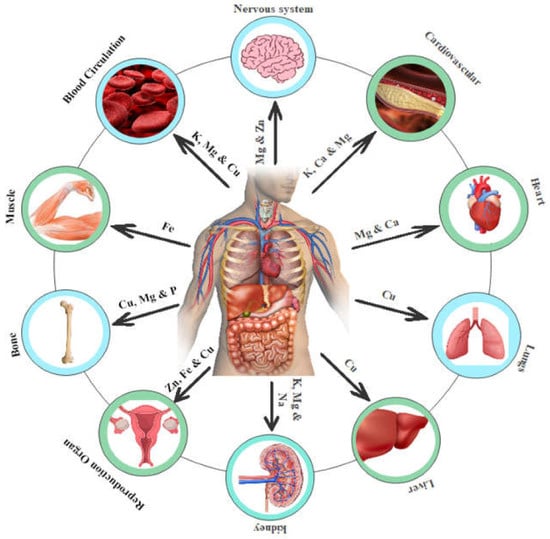1. Small Indigenous Fish Species (SIS)
According to several scientists, fish that can grow to 25 cm or 9 inches at the mature or adult life cycle stage are known as SIS [
3,
23]. However, some SIS such as
Heteropneustes fossilis can grow more than 9 inches or 25 cm. SIS are an essential source of nutrition for many communities worldwide. These small fish are often overlooked when considering sources of protein, yet they provide a vital source of nutrition for people living in poverty. They also provide essential nutrients to those living in remote areas who may not have access to other food sources. The importance of these SIS lies in their ability to provide essential nutrients and vitamins that are hard to find elsewhere. This article will explore the nutritional significance of SIS and how they can be a sustainable food in Bangladesh and the world.
2. SIS Resources and Their Micronutrients
Bangladesh is one of the most significant inland fishing countries in the world. Out of 251 different inland fish species, Bangladesh’s water bodies are home to more than 150 SIS of fish [
24]. Diversified water bodies (ponds, beels, haors, baors, rice fields, floodplains, etc.) are excellent breeding and rearing grounds, with an abundance of natural food, space, and appropriate environment [
12]. They can spread quickly to other natural water bodies due to their ability to spawn in narrow and shallow water bodies; as the rainy season passes, their abundance rises, especially when water bodies reach their maximum levels. These water bodies do not have any naturally occurring species-specific populations. It essentially aids in obtaining the fundamental broodstock required for pond production through breeding and recruitment [
24]. The most common catches of SIS are Puti, Darkina, Mola, Chanda, Koi, Taki, Cheng, Tengra, Gochi, and Magur [
21].
In the Indian sub-continent, SIS of fish in inland water bodies (freshwater wetlands and rivers) are found in sufficient quantity. Except for a few exceptions, most SIS do not integrate into a standard cultural context even though they differ in classification, shape, size, and eating habits. In addition to their unique cultural systems, they are regarded as one of the traditional dishes in most Asian nations, such as India, Bangladesh, Vietnam, Laos, etc., to make up for dietary deficits [
9,
25,
26,
27]. SIS are a valued food ingredient that supplies a variety of vitamins and minerals in addition to proteins [
4,
28] (
Figure 2). Small fish species, being widely available, are a boon for persons of lower socio-economic status, even though it allows people to have essential dietary components.
Figure 2. Importance of SIS in the context of Bangladesh.
Different types of fish species, amphibians, molluscs, crustaceans, etc., coexist in natural resources (e.g., rivers, canals, banks, ponds, low water bodies, rice fields) in very varied quantities. Among them, the nutrition content is highest in small fish, and they live in diverse and abundant ecosystems [
8]. The local people catch small fish from their local water bodies and bring them to sell in the local market. The soil topography and ecosystem sample of various rivers, channels, and rice fields of Bangladesh, West Bengal, and Assam bring diversity among small fish. The relative abundance of these species is consistent with observations made from paddy fields and associated trap ponds in the respective areas [
29]. Traditional fishing gear is usually used to collect SIS from paddy fields and attached trap ponds. Due to the structural characteristics of the equipment [
30,
31], fish with low biomass are more prone to such traps than fish with high biomass, resulting in species size and composition as observed of different SIS species sold on the market. Biomass and abundance characteristics of SIS are similar to those observed from the Padma River in Bangladesh [
32]. Perhaps the connections between rivers, irrigation canals, and rice fields provide a continuum of freshwater habitats that facilitate the movement of fish species across different landscapes. Fish species’ specific preferences for habitat (canals, rivers, or rice fields) may contribute to differences in encounter rates and captures in the three systems [
25]. The diverse ecosystem services attributed to SIS qualify as a valuable aquatic living resource that requires sustainable exploitation. Due to SIS’s abundance and food value, continued exploitation is essential, especially locally. Strategies to increase the abundance of SIS through polyculture [
33] or rice fish farming [
34,
35] can be a viable option to maintain demand at the local scale of the respective geographical area [
36]. Apart from their role in food security, various species of SIS are in high demand in the ornamental fish trade and biological control of mosquitoes.
People worldwide have a common need to consume safe and nutritious food. Availability, adequate access, utilization, and safety combine to define food security [
34] entirely. According to Gross et al. [
37], “food security is the excess of enough food for every person in the world to lead a healthy life at all times”. Food insecurity occurs whenever this standard amount cannot be fulfilled, especially in developing countries. Despite the improvement in the sector, currently, 36 percent of the total population is suffering from IPC Level 1, and 43% is suffering from IPC Level 2, which, in 2009–2010 was two-thirds of the population, mainly rural household people.
In most cases, women are more vulnerable to food insecurity since they have less access to land and water, have less financial support, and look after the needs of others in the family rather than themselves, and a thing is to raise them in malnutrition and under-nourishment from a young age. Small fish are one of the food items that make it possible for rural people to meet the adequate demand for these nutrients and eliminate food insecurity. For example, the most available small fish, mola, is one of the main sources of vitamin A. It is considered one of the easiest ways to cure diseases, as it is necessary to eat this fish to cure significant diseases such as night blood disease and vitamin A deficiency. In addition, small fish are a reservoir of different minerals (e.g., Zn, P, Mg, Ca, etc.) compared to other food sources. In Cambodia, less expensive small fish also meet the zinc requirement of the lower class. The calcium from skimmed milk is often equal to that from small fish. In addition to meeting the requirements of macronutrients, the role of SIS is immense in meeting the needs of micronutrients, eliminating animal protein deficiency, and as a natural supplement [
36]. Based on the size, age, variety, food habits, and feeding habits of small fish, their amount of nutrients can vary [
12].
The successful linking of human nutrition and fisheries to address micronutrient deficiencies is relevant for other countries with rich fishery resources, such as Cambodia and those in the Lake Victoria region of Africa [
17].
The nutritional content of these fish varies depending on cleaning techniques, discarded parts, and pre- and post-cooking weights. In this case, the nutrient analysis of their raw, clean cuts and waste materials has been documented and connected in the above-mentioned table. Small fish are preserved and consumed all year round in Bangladesh through a variety of techniques, including pickling during the pick production phase and drying and preserving small prawns using Sidal and Shut. Small fish are consumed in enormous quantities in Cambodia in various forms, such as fish sauce, fish paste, and preserved small fish. Some are consumed as dried fish, salted fish, fermented fish, and smoked fish [
39]. Thus, tiny fish directly cooked or stored meet 40% and 31% of Bangladesh’s needs for vitamin A and calcium, respectively [
17]. Small plants and animals make up the majority of the diet of small fish. They have more nutrients in their bodies since they grow up in a natural setting and eat natural foods. Small fish are the only method to ensure that the next generation is talented and healthy (
Figure 3). “The more popular little fish are in countries, the healthier and smarter children are growing up”, said World Fish’s nutrition and public health director.
Figure 3. A diagram for the better utilization of SIS, their economic importance, and their impact on the human body.
The whole body of SIS is edible, with head, bones, eyes, and viscera, without any plate waste, making the food rich in nutrients. Mola fish has the most vitamin E in the eyes, so one must be careful while cleaning this fish so that the head is not separated from the body and is eaten with the head, eyes, and bones. The amount of vitamin A in sun-dried fish reaches almost zero [
40]. The amount of minerals (e.g., Ca, Zn, Fe, P, etc.) present in the fish with a head is comparatively higher during cleaning than in the whole fish except the head [
8]. Based on the growth percentage of Vitamin A2 in a rat’s body, 40% of biological activity is shown to calculate RAE from fish samples [
41]. The high amount of calcium found in the human body and rat’s milk can be obtained from mallow fish [
42,
43]. A total of 25% from both haem iron and non-haem iron and 10 percent from inorganic iron we can get from fish bodies. However, the cooking method can alter this bioavailability, as trey changwa plieng, a Cambodian fish dish, provides more heme iron than fried fish [
17]. The animal body has more zinc than plants, especially fish. Boiled rice and sour soup is one of the traditional, everyday food items of Cambodia’s poor population; when cooked with a trey changwa plieng, it meets 45% of a woman’s daily iron needs. On average, a woman consumes 367 g of rice and 257 g of sour soup, and 49 g of fish per day. Again, 100 g of sour soup for a child contains only 25% and covers 42% of the child’s daily iron requirement, whereas a child’s daily iron requirement is 0.42 g of iron [
17]. Apart from these, the absorption of non-heme iron and zinc can be obtained from everyday ingredients, especially fatty acids, in addition to easily absorbable iron [
8].
3. Vitamins
Every organism needs very modest amounts of vitamins to carry out its essential tasks. They play similar roles at each stage of the life cycle. Many physical and mental illnesses are brought on by a deficiency of these microelements (
Figure 4). Depending upon their solubility, vitamins are one of two types: fat-soluble (vitamins A, D, E, K) [
44] or water-soluble (vitamin C and vitamin B complex) [
12]. The vitamin B series (vitamin B1, vitamin B2, vitamin B3, vitamin B5, vitamin B6, vitamin B7, vitamin B9, and vitamin B10) have been recognized as coenzymes or cofactors. The components of coenzymes participate in numerous biochemical reactions involving blood coagulation, hormone production, energy release, etc. For example, the active coenzyme forms of Thiamine (B1), Riboflavin (B2), and Niacin (B3) are TPP, FAD, and NAD/NADH, respectively. Pantothenic acid (vitamin B5) is a component of coenzyme A that is necessary for metabolizing carbohydrates, amino acids, and other biomolecules [
12]. Pyridoxine is a coenzyme form of vitamin B6. Biotin (vitamin B7), as a coenzyme, supports the function of carboxylase, pyrimidine synthesis, and urea formation [
21].
Figure 4. Contribution and preventive deficiency of vitamins in the presence of SIS, effective activities on the cellular level in the human body. The deficiency of fat-soluble vitamins can create several health-related problems, including night blindness and xerophthalmia [
45,
46] in the human body. Mola is a typical SIS of Bangladesh containing a huge amount of vitamin A; distribution of vitamin A in the different parts of the mola was based on the study of Roos et al. [
3]. The figure was partially modified from Thilsted [
8].
Folate (vitamin B9) is a coenzyme required for purine biosynthesis and plays a vital role in forming heme, the iron-containing substance in hemoglobin. Cobalamin (B12), a component of cobamide coenzymes, is required to maintain cellular integrity by keeping the standard structure of the cell membrane intact. Fish is an excellent source of vitamins, particularly vitamins A, D, and E as well as B1 and B2. Vitamin A produces eye pigments that prevent eye damage and blindness, and its deficiency is prevalent in developing countries, especially for children and women [
45]. Some studies indicate that vegetarians (80–90%) suffer from vitamin B12 deficiency since it is only sufficient in animal food (i.e., small indigenous fish).
3.1. Vitamin A
Vitamin A (retinol, retinoic acid) is essential for eye health, immune function, cell growth, and reproduction [
44]. The most common and first sign of Vitamin A deficiency is night blindness (poor vision at night or in dim light). According to WHO, 250,000–500,000 children become blind, and half of them die within 12 months because of losing sight. Humans generally need little amount of this vitamin: the recommended daily allowance of micrograms is 900 micrograms for men and 800 micrograms for women, with an additional dose for pregnant women [
21].
3.2. Vitamin B12
Food derived from animals, including fish and shellfish, is a good source of vitamin B12, which is essential for cell division, blood formation, DNA formation, nerve function, etc. It is a highly complex essential vitamin chemically known as Cobalamin. The vitamin B12 content of the above-mentioned small fish ranged from 0.90 to 12.8 µg per 100 g, and their analytical methods varied [
21]. The highest amount was found in Shing fish and the lowest in Meni and Bheda fish [
21]. A total of 22% of adult women are vitamin B12 deficient, with negative effects on their health, neural development, and function, which has drawn special attention in the public health sector nationally [
49]. As the whole source of vitamin B12 is animal-based, in the context of Bangladesh, small fish can play a very important and increasing role in meeting its deficiency and maintaining a proper diet chart [
50].
3.3. Vitamin D
Naturally-produced vitamin D3 (cholecalciferol) is found in animals. It is stated that only zooplankton and microalgae are considered plankton sources of vitamin D2, and fish eat these as a part of their diet [
51]. Several studies show that vitamin D helps calcium and phosphorus absorption, controls infection, reduces inflammation, prevents cancer, etc. Lack of vitamin D can cause osteoporosis, bone loss, muscle weakness, rickets, etc., [
21]. Fish have been considered an excellent source of vitamin D, especially fish oil [
44].
3.4. Vitamin E
Naturally-sourced vitamin E exists in eight chemical forms: alpha-, beta-, gamma-, and delta-tocopherol, and alpha-, beta-, gamma-, and delta-tocotrienol. Among all of them, only alpha-tocopherol, with the highest biological activity, can meet human requirements. According to the analysis, alpha-tocopherol could not be found in 3 species (koi, chapila, baim) out of the 28 species tested. It is found to be highest (0.91 µg) in mola and lowest (0.09 µg) in kachki. Vitamin E is involved in immune function, preventing blood clogging, metabolic process, regulation of gene expression, and activity of protein kinase, and also increases the expression of two genes [
53]. Vitamin E deficiencies cause nerve impulses, muscle weakness, and the inherited disorder AVED (ataxia and vitamin E deficiency) [
54].
3.5. Vitamin B9 (Folate)
In the above-mentioned table, maximum vitamin B9 was obtained at 18 µg in Foli and at a minimum of m 2.9 µg in Bashpata and Kajuli. The required amount of vitamin B9 for adults is 500–600 µg per day, but, for children, it is 80–150 µg/per day, most of which is met through the consumption of small fish in the population of Bangladesh [
21]. Folate is a component in various physiological needs, including red blood cell formation, cell growth and function, RNA and DNA formation, and protein metabolism. A total of 30 to 50 percent of the human body’s cellular folate resides in microconidia [
50].
4. Minerals
Minerals are essential food components of the human body that are required in minimal quantities, but they play a key role in managing various important physical and biological functions. Minerals can be of two types, micronutrients and macronutrients. Small fish usually contain a large number of macro minerals such as calcium and phosphorus [
12]. According to FAO, we can broadly divide food into three categories: 1. cereals, 2. non-staple plant food, and 3. animal and fish products. Cereals are the primary level of energy among these three types, but they contain very few micronutrients. Basically, micronutrient-complete foods can be included in non-staple plant food lists. We obtain the maximum amount of energy, vitamins, minerals, and other air molecules in food from animal and fish products. Small indigenous fish species from inland water bodies are not only a source of protein but also a large storehouse of various minerals, micronutrients, and macronutrients [
49,
55]
The presence of a standard amount of these minerals (e.g., copper, zinc, selenium, iodine, magnesium, iron, cobalt, and chromium) in the diet is essential for human health. A lack of sufficient amounts of minerals causes many diseases in the human body. For example, calcium deficiency can cause osteoporosis and bone loss [
56]; lack of zinc causes immune dysfunction, growth inhibition, and sexual dysfunction. The deficiency of iron and copper causes diseases such as anemia [
57]. Not only can food intake meet all the physiological needs of the human body, but a sufficient supply of minerals is essential for its full functioning [
58]. Currently, various minerals are commercially available within the market, but their absorption levels and solubility are very low. Required health of minerals is shown in
Figure 5.
Figure 5. Average mineral requirements for the human body [
21].
4.1. Iron
From the data of Bogard et al. [
21], we can see that three species (chapila, darkina, and mola) can meet 25% of the RNI for PLW by having iron contents that range from 0.46 to 19 mg/100 g. Compared to wild mola fish (5 mg/100 g), cultivated mola has been found to have a significantly greater iron content (19 mg/100 g). Analyses of iron content may reveal systematic variations or actual variations in iron buildup among various species depending on the context. The data provided here suggest that a number of locally endemic tiny fish species may considerably contribute to the consumption of iron, the most essential trace element in the diet in Bangladesh, which has a high bioavailability as foods derived from animals [
59]. It is found in every body cell of vertebrates. It is crucial for many processes, including biochemical ones, reactions involving the transfer of electrons, the control of genes, the movement of oxygen, and the growth, regulation, and differentiation of cells [
60]. Iron’s primary function in the body is to produce hemoglobin for red blood cells, which contains heme in its pure form (
Figure 6). The molecule known as hemoglobin transports oxygen to tissues and removes carbon dioxide from cells [
12]. It is well known that the Fe-containing enzyme hydrogen peroxidase reacts with reactive compounds produced as byproducts of oxygen metabolism. Non-heme, iron-content enzymes including succinate dehydrogenase, nicotinamide adenine dinucleotide (NADH) dehydrogenase, and xanthine oxidase aid in energy metabolism. These enzymes are found in iron-sulfur cluster proteins [
60].
4.2. Zinc
Zinc is essential to maintaining good health because it involves more than 200 enzymatic reactions in catabolic processes, immune response, wound healing, and sexual maturation [
12] (
Figure 6). Indigenous species of fish carry Zn in high concentrations. The zinc concentration varies from about 0.60 to 4.7 mg/100 g in fish and seafoods [
61]. Among the species, four species, chela, mola, darkina, and rani, meet 25% of the RNI for PLWs, and only chela and mola meet 25% of the RNI standard for infants. In addition, six naturally-occurring species, dhela, ekthute, kachki, mola, and Ttengra, fill 20 to 25 percent of RNIs, and darkina, dhela, ekthute, mola, tit punti, and rani fill 20 to 25% of RNIs for infants [
21]. According to recent studies, 57% of women and 44% of preschool children in the total population of Bangladesh suffer from zinc deficiency, which has become a national concern [
62]. SIS are rich in zinc, so they can easily be added to diet plans to meet zinc requirements. Zinc is a core element in various genetic processes, including DNA formation and replication and cell division and growth [
58].
Figure 6. Bioactivity of different minerals in the human body [
63] Small fish contain several minerals [
64] that are helpful for human health.
4.3. Calcium
Calcium is the most abundant mineral in the body that makes up 1.5–2.0 percent of the total body weight. As 99% of the body’s bones are composed of calcium, the major function of calcium is to maintain healthy bones, teeth, or components related to these (
Figure 6). Scientists suggest that one should consume 100 mg of calcium per day [
21]. This trend is also seen in the calcium content of the 29 species in the table above, with an average value of 879.5 mg. Since SIS are consumed whole with bones, calcium is considered a highly available dietary food item for humans [
17,
43]. According to the report, 550,000 children suffered from rickets due to calcium deficiency in 2008, and, from various studies, two sub-discs of Bangladesh, especially women and children, do not have enough calcium in their daily diet [
65,
66]. Although, in developed countries, there is a trend to meet the demand for most of the calcium calcium-containing products, in developing countries such as Bangladesh, it is challenging to meet this demand for dairy products. Therefore, the importance of small fish is immense in filling calcium deficiency [
9]. The contribution of calcium to muscle contraction, relaxation, normal heart rhythm, fatty acid oxidation, nerve function, and as a carrier of ATP in mitochondria is irreplaceable [
50].
4.4. Iodine
The iodine content of food typically depends on its environmental conditions. Marine fish are rich in iodine. The average iodine content of small freshwater fish is 43.6 µg/100 g; the highest value is 81 µg/100 g in darkina, and the lowest is 6 µg/100 g in kachki fish. In the table above, the amount of iodine could not be detected in these three fish: koi, shing and foli [
21]. Iodine plays an essential role in regulating the biochemical functions of the human body, maintaining hormone levels, and maintaining the release of thyroxine hormone to support the body’s metabolism (
Figure 6). Currently, the economic importance of iodine has appeared beyond the function of the human body. Its commercial demand is increasing as various pharmaceuticals, disinfectants, photography elements, and feed supplements [
12].
4.5. Selenium
Selenium is a critical trace mineral that plays a vital part in enzymatic contrast, antioxidant and catalyst generation, cellular production, immunological function, fertility, etc (
Figure 6). Selenium is also needed to develop human skin, hair, and nails. In the human body, selenium exists in two different forms: inorganic forms, which are free of amino acids, and organic forms, which are bound to amino acids. Small fish should be consumed frequently by everyone, but especially by individuals with thyroid issues. Small fish contain selenium, which enhances thyroid function. Selenium aids in preventing cancer, cardiovascular disease, thyroid problems, oxidative damage, lowering inflammation, and preventing artery aggregation [
12]. The amount of selenium in the environment, particularly in the soil and water where it grows, often varies. Selenium is typically found in fish eggs [
21]. According to FAO reports, the selenium level in small fish typically ranges from 5 to 49 µg/100 g.
4.6. Other Minerals
Phosphorus is a body’s electrolyte that maintains an electric charge and is essential for structural components of nucleotide coenzymes. Phosphate is a building block necessary for teeth and bone formation and energy production [
50]. Phosphorus ranged from 140 to 190 mg/100 g in the edible parts, including bones in small fish species, reported by FAO [
21]. Phosphorus content is measured either spectrophotometrically or by ICP-ACE. Magnesium ranged between 21 and 57 mg/100 g obtained from the whole fish body. It is a critical intracellular divalent cation that is essential for protein synthesis, cell replication, energy metabolism, muscle contraction, nerve conduction, and so on [
50]. About 50–70% of the fish Mg was located in skeletal tissue and scales. The sodium concentration of fish varied between 26 mg and 110 mg/100 g, which was generally similar to other SIS reports. The required amount of sodium ions mentioned in
Figure 5 is 90 g in the human body. In a constrained level, the noticeable dimensions of fine scheelite with its floatation value rise according to the variation of energy input, the size distribution of fine scheelite shifts from unimodal to bimodal [
67]. The potassium level of fish varied from 58–350 mg/100 g, which was generally comparable with other reports of small indigenous fish. According to the committee, a fair amount of research shows a link between potassium consumption and adult blood pressure decrease, which consequently affects their risk of coronary heart disease and stroke. Additionally, there is growing documentation that sufficient digestible potassium has a preventive impact against kidney stone formation and age-related bone loss. The manganese level of fish was 0.021–2.3 mg/100 g, which was generally similar to values noted previously by small indigenous fish species. General activities of manganese on health by gluconeogenesis and the impact on cofactors of numerous enzymes are involved in carbohydrate metabolism [
50]. The concentration of sulfur in the fish varied from 160–260 mg/100 g, which was generally comparable with other reports of small indigenous fish. The increasing levels of primary and secondary metabolites, H
2O
2, and malondialdehyde (MDA) were found both in the roots and the leaves, indicating that the growth was negatively impacted by oxidative stress and that the antioxidant defense system was insufficiently able to maintain the redox equilibrium of the cell [
68]. The copper level of fish varied from 0.029 mg to 0.094 mg/100 g, substantially in line with other reports of small indigenous fish. An important cofactor of the mitochondrial respiratory chain enzyme, cytochrome-C-oxidase, is involved in iron metabolism [
50]. Nearly every species had indistinguishable levels of chromium. There is an exception of cultivated mola, which had extremely low quantities of chromium of 0.027 mg/100 g, which was also compatible with information from other sources. People who exercise vigorously have been observed to have increased urine levels of chromium. The health impact potentiates insulin activity, boosting glucose absorption by the cells [
50].
This entry is adapted from the peer-reviewed paper 10.3390/hydrobiology2010014
